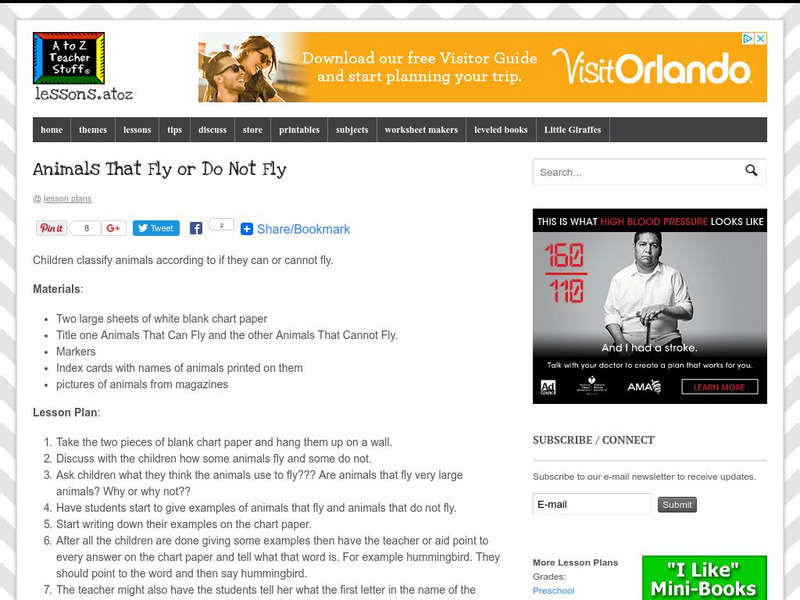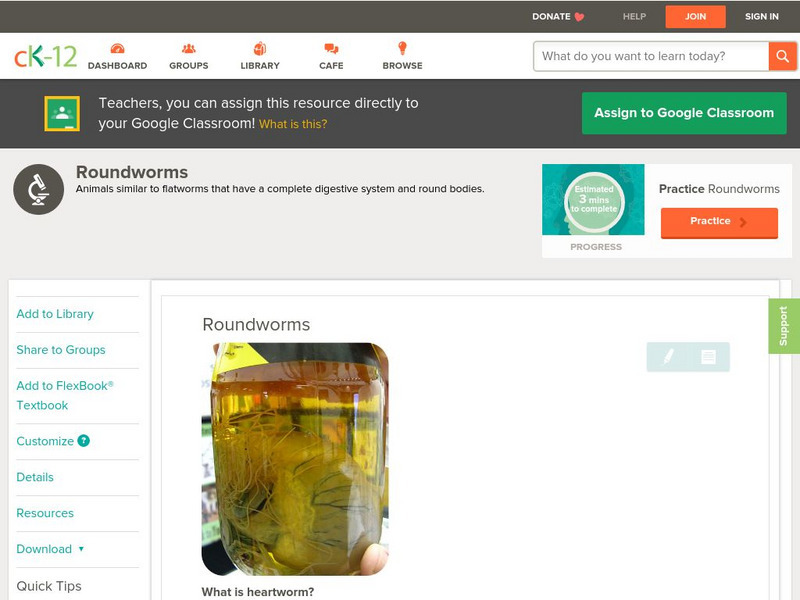Hi, what do you want to do?
Sophia Learning
Sophia: Animals: Invertebrates: Lesson 4
This lesson will explain the characteristics of animals that are classified as invertebrates. It is 4 of 4 in the series titled "Animals: Invertebrates."
Sophia Learning
Sophia: Animals: Vertebrates: Lesson 2
This lesson will explain the characteristics of animals that are classified as vertebrates. It is 2 of 4 in the series titled "Animals: Vertebrates."
Sophia Learning
Sophia: Animals: Vertebrates: Lesson 4
This lesson will explain the characteristics of animals that are classified as vertebrates. It is 4 of 4 in the series titled "Animals: Vertebrates."
Fundación Cientec
Ecologia Y Matematica Entretejidas
Four lesson plans in Spanish for elementary math and science class. Young scholars are required to classify animals and make observations. Offers explanations and detail of the lessons and methodology it is based in.
Discovery Education
Discovery Education: Animal Classification
Use this lesson to help learners understand the reasons for classifications and ways that different species are separated.
PBS
Pbs Learning Media: Pre K 12 Resources for New School Routines: Creative Problem Solving Bingo: Pre K and K
These weekly activities are cross-curricular but emphasize Social-Emotional Learning, Math, and Literacy development. This week (January 4th), we are working on problem-solving.m
Science Education Resource Center at Carleton College
Serc: Introduction to Dichotomous Keys
This lesson serves as an introduction to the classification of plants and animals or trees. Students will investigate how to classify objects based on their similarities and differences. They will use technical writing to explain their...
California Institute of Technology
Infrared Zoo Lesson 1: A Trip to the Infrared Zoo
Students will use infrared images to classify different animals. Students will learn more about infrared imaging and the information it can reveal. This activity is guaranteed to activate great class discussion.
A to Z Teacher Stuff
Lesson Plan: Classifying Animals
Students classify animals according to whether or not they can fly. The lesson plan includes instructions and materials.
How Stuff Works
How Stuff Works: What's Considered Big Game?
Explains what is classified as big game in hunting, something that depends on where you are hunting, for example, in the U.S. or in Africa. Touches on the business aspects of big game hunting, then looks at hunting regulations in...
ClassFlow
Class Flow: Listening for Sounds
[Free Registration/Login Required] This flipchart has the students working on their listening skills with various activities as well as the alphabet cheer, a Big Book, and classifying people and animals.
ClassFlow
Class Flow: Animal Sorting
[Free Registration/Login Required] This K-2 flipchart is designed to make animal classification fun! Sort the animals into categories and think like a scientist!
Mocomi & Anibrain Digital Technologies
Mocomi: Kingdom Classification of Living Organisms
Learn about who created the classification of living things, how they are classified, and the six different kingdoms.
Sheppard Software
Sheppard Software: Parts of the Food Chain: Producers, Consumers, Decomposers
Learn how scientists classify different types of organisms in an ecosystem or in a food chain by their role and function as either a producer, a consumer, or a decomposer. Then play a game that tests your understanding of these important...
Other
It's All About What's Inside. Classification and the Tree of Life [Pdf]
In this science lesson plan, learners look at how animals have traditionally been classified in a tree of life diagram by examining the characteristics of plastic eggs. They then analyze the genetic code assigned for each egg and look...
CK-12 Foundation
Ck 12: Episd: Animal Characteristics
[Free Registration/Login may be required to access all resource tools.] Students will be able to identify and classify organisms that are animals based on recognition of traits presented.
CK-12 Foundation
Ck 12: Episd: Animal Classification
[Free Registration/Login may be required to access all resource tools.] Check out the diverse traits that animals can have that put them into different Phyla to make it easier to classify them.
Curated OER
Science Kids: Science Images: Polar Bear With Cubs
This photo shows a polar bear with two cute cubs sitting in the snow. Polar bears are native to the Arctic Circle and are classified as a vulnerable species. Polar bears are the largest type of bear and also the largest carnivores that...
Other
University of Aberdeen: The Phyla of Kingdom Animalia
Very systematic breakdown of the animal kingdom starting with the simplest type the sponge, all the way to the chordate or vertebrate. Each phylum has a link with information.
Khan Academy
Khan Academy: Theories of the Early Stages of Language Acquisition
Language is the primary method of human communication, but there are also other ways to communicate without the use of language. Language in its most complex form is unique to humans, although some animals have been found to have basic...
Smithsonian Institution
Smithsonian National Zoo: Classification Systems
A great overview of the science of classification. Topics addressed include summaries of the five kingdoms, the seven taxa, the definition of a species and the classification of the panda.
CK-12 Foundation
Ck 12: Life Science: Roundworms
[Free Registration/Login may be required to access all resource tools.] The word "worm" is not very scientific. This informal term describes animals that have long bodies with no arms or legs. Worms with round, non-segmented bodies are...
Other
Alternative Classifications of Life
The Linnaean system (1758) classified all macroscopic living organisms as either Animals or Plants, based on whether they moved [anima, with a soul] or not. Thus, Fungi were included as plants. With the invention of the microscope and...
PBS
Pbs Learning Media: Just for You
Students are asked to explain how plants and animals may be classified as natural resources.





















